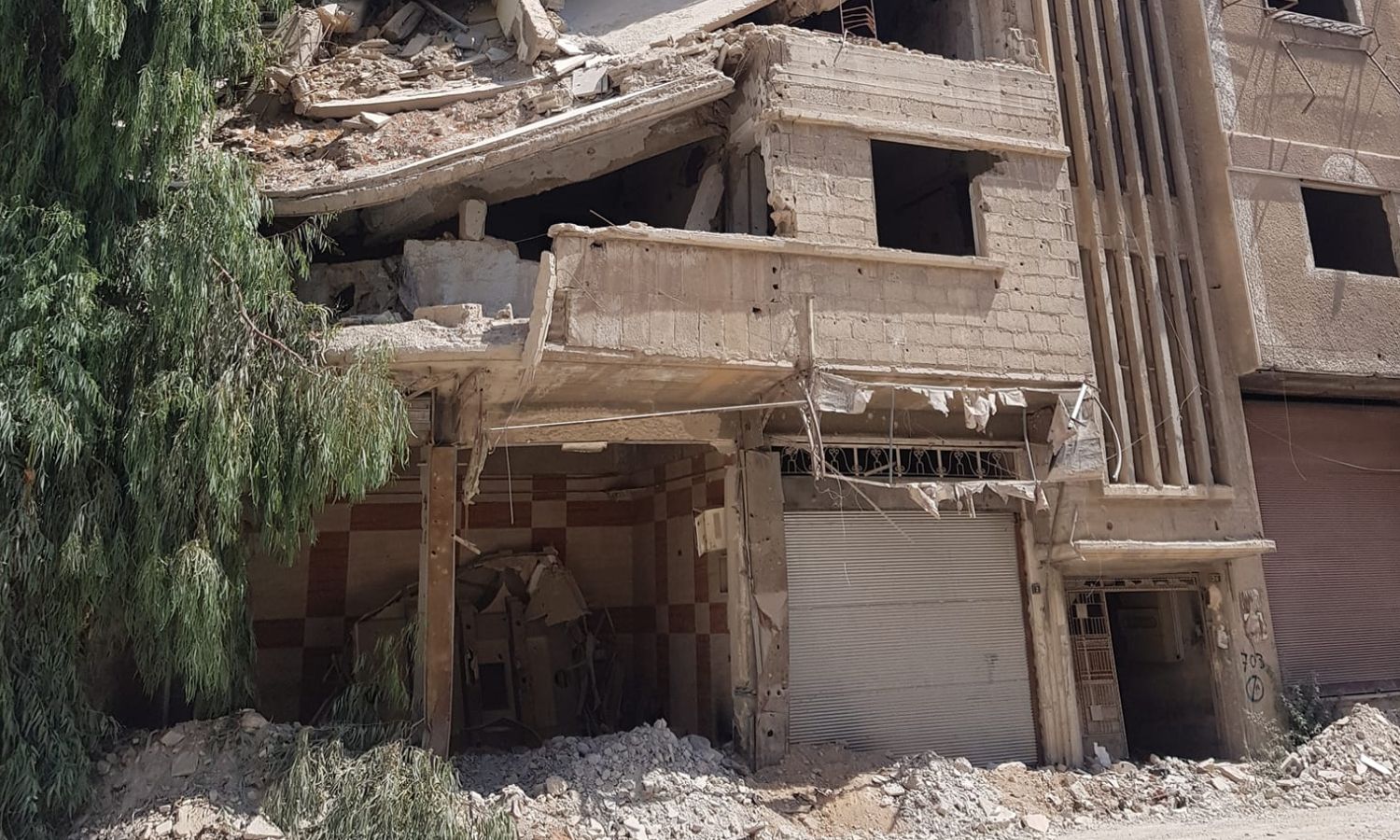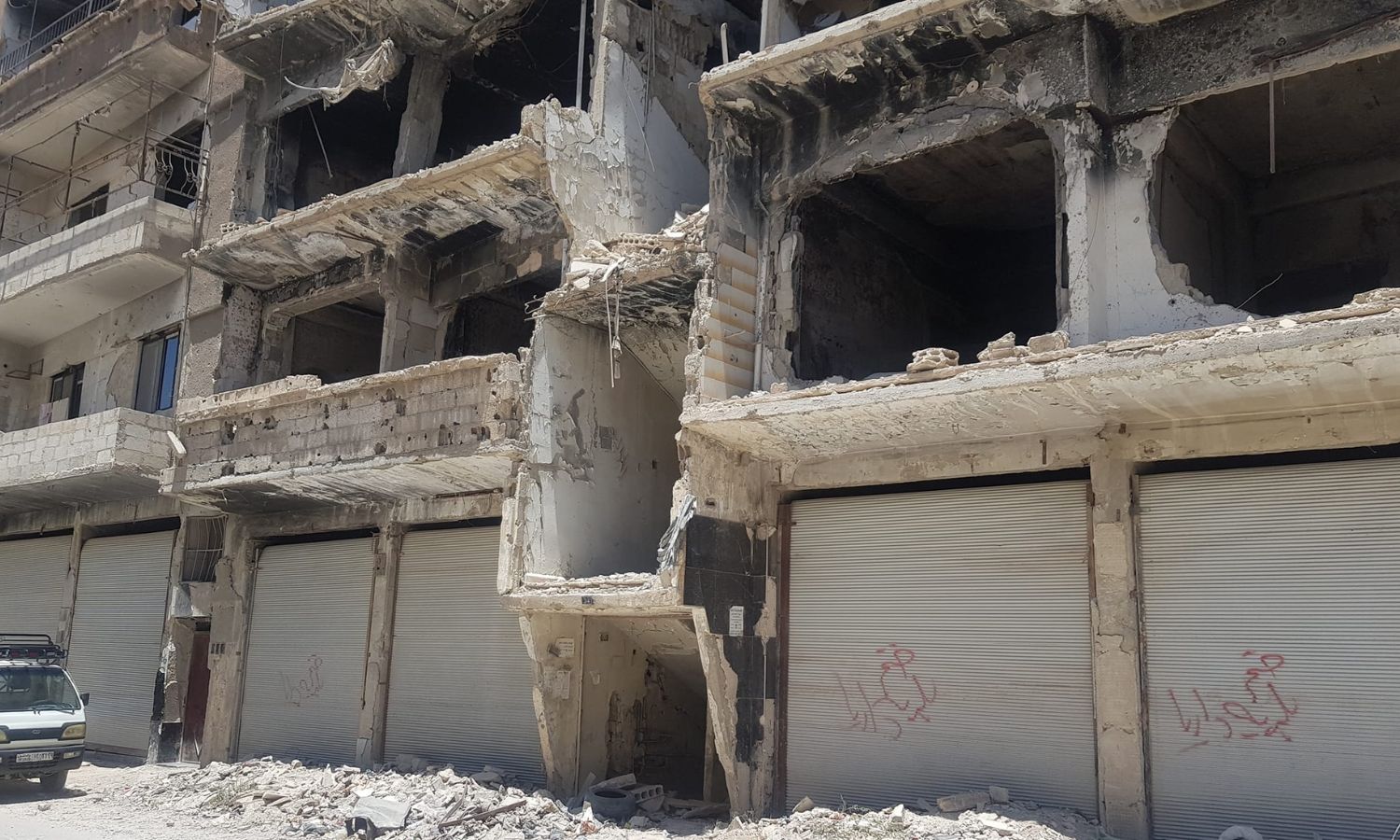



The city of Daraya in the western Damascus countryside is witnessing increased activity to restore collapsed buildings as a result of the bombing. This has been accompanied by significant activity in real estate buying and selling operations, amid legal and security obstacles that disrupt this activity within large neighborhoods.
“At very low prices,” buying and selling operations are carried out through brokers or agents, according to what a real estate broker who owns an office in Daraya told Enab Baladi, who requested that his name not be mentioned for security reasons.
Most sales of homes and agricultural land take place through contracts without transferring ownership, as the buyer needs to go through complex procedures and pay bribes to notaries in the regime’s courts to take this procedure.
These complications make the transfer of ownership a postponed transaction indefinitely, which contributed to the decline in prices, while it has been clear for years that the regime’s government wanted to take control of some of Daraya’s neighborhoods through state-organized urban housing plans, the most prominent of which is the al-Khaleej neighborhood.
The real estate broker explained that sale operations take place through intermediaries and agents in the absence of most of the original owners, and properties are sold under different descriptions, such as an apartment whose furnishings and main materials were stolen or an apartment without complete cladding, uncultivated land, a demolished house, and a rehabilitated house.
He stated that buying and selling operations take place within the areas to which the regime forces allowed their owners to return.
The broker pointed out that the al-Khaleej neighborhood, the most prominent neighborhood in the city, did not witness sales, with the presence of people willing to sell at “attractive” prices, with the exception of some cases that took place through intermediaries who have a relationship with security agencies.
He explained that the buyers were officers or officials connected to the regime and knew the fate of the region, as the selling process was complex and risky, and it was carried out under pressure from the seller offering to sell at the lowest price in order to collect part of his rights.

Buildings destroyed by air strikes in the city of Daraya in the western countryside of Damascus – 2022 (Daraya City Local Council)
In Daraya, shops, and real estate are sold at unstable prices and are not estimated by area but rather according to the neighborhood and the extent of its rehabilitation, in addition to the principle of supply and demand.
Residential apartments and shops are sold under several names: “looted,” “clean cladding,” “destroyed,” or others, and their prices start from 10 million pounds to 300 million pounds (between $730 and $2,200).
In the recent period, the number of properties offered for sale has increased with a decline in demand, due to the desire of residents to sell their properties to obtain another place to live in due to the deteriorating living conditions and the significant decline in services within Daraya.
“Heaven without people is unbearable to live in,” with this popular saying, Riyad Abu Ahmad, 46, explains the reason for recently putting his house up for sale in Daraya, saying, “I decided to sell my house and buy another in the neighboring city of Muadamiyat al-Sham, as it has better services.”
He added to Enab Baladi that the price of his house, which consists of four rooms and an area of about 120 m2, will perhaps enable him to buy a house whose area does not exceed 70 m2.
Abu Ahmad offered his house for sale through Facebook groups dedicated to buying and selling in Daraya. He asked for an initial price of 150 million pounds and is waiting for a customer to speak to him to agree on the price he will pay without any negotiation. “The important thing today is that you find a customer who will buy, and do not ask about the price,” he added.
The US dollar is trading at 13,850 SYP according to the S-P Today website, which covers the trading rate of the Syrian pound to the dollar. At the start of the conflict in 2011, the dollar was trading at 47 pounds.
According to the Anti-Terrorism Act, issued by the Syrian regime, anyone accused of supporting “terrorism” can have his money seized, and this is what the people fear will happen, and therefore they will not be able to claim their property for fear of being held accountable and arrested.
In its first article, the Anti-Terrorism Act defines confiscation as “the permanent deprivation of movable and immovable property, and the transfer of its ownership to the state pursuant to a judicial ruling.”
Lawyer Jalal, from Daraya, told Enab Baladi that residents have become aware during the recent period of an increase in violations against their property, as brokers have begun dealing with counterfeiters to conduct fictitious buying and selling transactions, especially real estate whose owners have been displaced from the city.
The lawyer explained that in the case of confirming ownership of lands and real estate, the owner needs one of the methods, such as having a title deed or resorting to filing a lawsuit in the courts for the people who are still in the area.
As for the people outside Daraya, they need to appoint a lawyer, pointing out that there is security accountability for the person appointed, which prompts lawyers to reject such cases.
In addition to these concerns, the Daraya City Council issues warnings and demolishes homes by photographing the construction and publishing it on Facebook. The reason is due to advice from local engineers or complaints from residents in that area.
The warning reports did not come in accordance with an official decision, but rather the matter was limited to the local council publishing a picture of the building to be demolished, notifying its owners to identify it and communicate with it to complete the removal process.
The al-Khaleej neighborhood is dominated by signs of destruction and remnants of bombing, which extends along the northern outskirts of the city and is adjacent to the fence of the Mezzeh military airport.
Since the beginning of their military campaign on Daraya in 2012, the regime forces have turned the al-Khaleej neighborhood into a battlefield, then bombed all its houses and erected a dirt berm around it to become the first line of defense for the Mezzeh airport campus, according to residents and local fighters in Daraya.
Seven years after the regime forces displaced the city’s people, they allowed the remaining residents to return to it again in batches under strict security checks.
Jumaa, originally from the al-Khaleej neighborhood, said that he was unable to return to live in his home, and is now residing in the home of one of his expatriate relatives, in the city center.
He told Enab Baladi that he was unable to return to his house, which had become rubble, but he was able to see the area where he lived from a distance because of the proximity of his house to the Mezzeh airport campus.
Daraya-based Bashir, 32, a pseudonym for security reasons, said that the houses in the al-Khaleej neighborhood are still in a destroyed state, and a dirt berm and several tunnels surround the area leading to the Mezzeh military airport, which is wide enough for a tank to cross through it.
Bashir explained that there are no guards or members of the regime forces surrounding the neighborhood, as residents can enter and wander its streets, but no house there was allowed to be rehabilitated.
He pointed out that walking around the neighborhood is on foot because the rubble and traces of destruction are still present.
After his return to the city, Muhannad was forced to rent a house in Daraya despite owning a house on the outskirts of the al-Khaleej neighborhood.
Muhannad said that he was able to visit his house, but he was unable to rehabilitate it or remove the rubble because the neighborhood did not fall within the planning framework set by the Daraya Executive Council.
It is the body responsible for organizing the return of the people, and it did not conduct any operations to remove the rubble or provide any services to rehabilitate the area.
Legally and in records, Muhannad is still the original owner of his house, but the follow-up of the file is linked to security agencies, and his lawyer did not dare to go further with the case.
The regime’s government had placed the al-Khaleej neighborhood within an organizational urban plan published by the Syrian Ministry of Public Works and Housing on April 24, 2018.
The area was categorized as informal housing, and the rate of urban damage was high; therefore, it was expressed in this plan as an empty area that had not been previously inhabited.
This matter reinforced fears that Law No. 10, would extend to that area, declaring it a new urban redevelopment area, under the pretext of addressing the problem of slums, surveying the entire area, and converting metric real estate ownership into shareholding real estate ownership only, without any right to compensation for those whose property was lost, especially since the vast majority of the population of that region are mainly refugees and displaced people outside areas of government control.
|
Law No. 10, which was enacted in April 2018, is seeking to reshape Syria’s Demographics since it allows the government to determine which areas of the country will be designated for reconstruction. The Washington Institute |
Under Law No. 10, the regime approved the establishment of two residential suburbs, one of which is mainly in Daraya and the second is also part of Daraya.
The first is called “Basilia City,” and it is residential area 102, and is located on the axis of Kafr Sousa-Mezzeh-Basateen al-Qanawat-Daraya. The second bears the number 101 and is called “Marota City,” and is located on the axis of South-Mezzeh- Kafr Sousa.
Law No. 10 of 2018, which stipulates the establishment of urban redevelopment areas within the general organizational plan of administrative units, is not limited to its application in a specific region in itself but rather includes various parts of Syria, whether they need reconstruction or not.
Whether they are random housing areas or not, this area is determined as soon as the official decision is issued by the Ministry of Local Administration to subject those areas to that decree. Then, the region will be redivided in an urban manner, and real estate ownership will become communal, which will place all regions within the Syrian geography under the sword of this law without definition and without clear control parameters.
if you think the article contain wrong information or you have additional details Send Correction